Best Place to Stay In Tokyo: Our Favorite Areas and Hotels!
Latest update: November 14, 2022
Tokyo – with almost 10 million inhabitants, the Japanese capital is one of the most populous cities in the world, made up of 23 districts called special wards. How are you supposed to search for a place to stay in a city that size? With us of course!
We recently visited the metropolis and explored it as best we could. While we were there, we found some interesting facts that might help you find a place to stay in Tokyo.
Tokyo really has something for everyone. The city is a symbol of pop culture, architectural wonders of the future, super-delicious food, the weirdest fashion trends, and shimmering neon lights.
But Tokyo doesn’t just offer a glimpse into the future but also into the past: The east side of the city has remained relatively unchanged for the past decades. There are beautiful hundred-year-old temples, traditional restaurants, and quiet, tidy streets here.
But if you’re more interested in the big city life, then the west side of the city is more worthwhile. This is where it’s happening in Tokyo: Huge shopping centers, cinemas, and night-long parties. But of course, the accommodations are also more expensive here.
Where’s the best place to stay in Tokyo?
We’ve put together a total of seven interesting neighborhoods to stay in Tokyo.
All the neighborhoods, with the exception of Asakusa and Roppongi, are located along the JR Yamanote Line. We’ve listed them in clockwise order along the circle line.
- Shibuya
- Shinjuku
- Ueno
- Asakusa
- Tokyo Station Area
- Ginza
- Roppongi
At the end of the post we’ve also added a section about our own hotels in Tokyo.
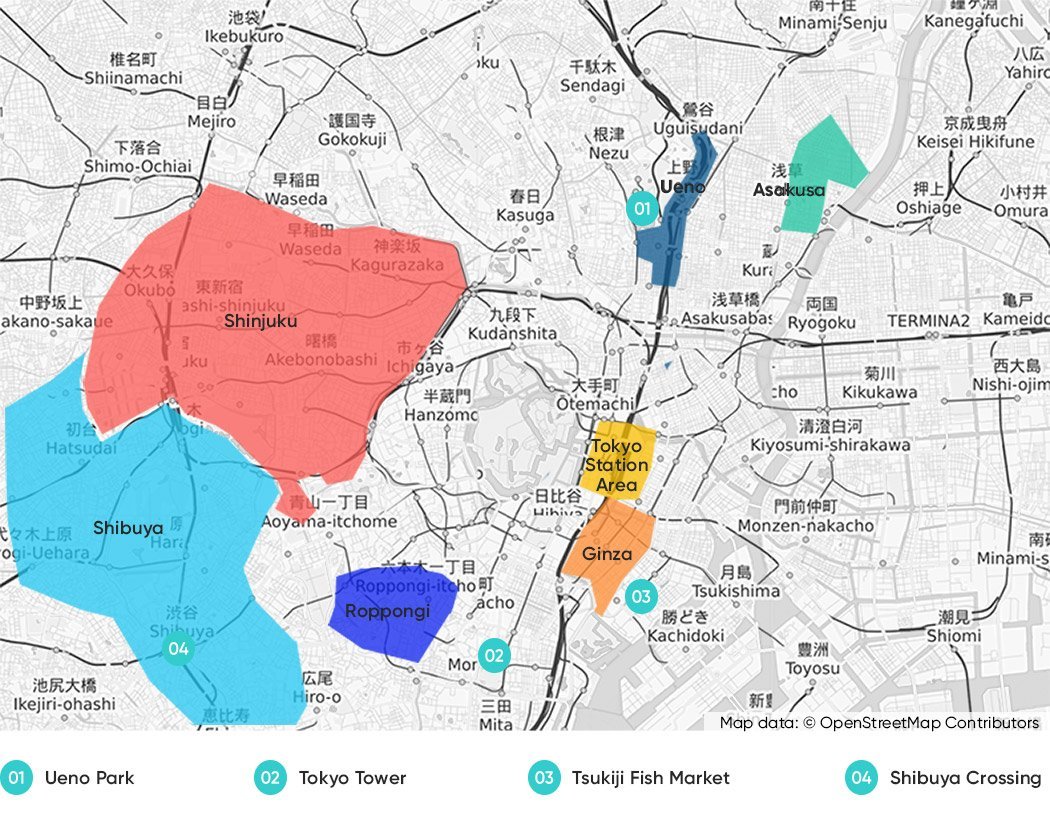
Shibuya: hip hot spot
Shibuya is one of the most popular neighborhoods in Tokyo and is located in the northwest. It’s simply impossible to get bored here. The streets are packed with attractions, restaurants, and all types of shops.
Young people in Tokyo like to meet up here in bizarre emo zombie outfits or to go shopping in narrow Takeshita Street, Tokyo’s subcultural hot spot.
Shibuya is also home to the famous Shibuya Crossing, the pulsating heart of the district, full of neon signs, boutiques, and packed streets.
The famous Omotesando Street is also located in Shibuya, with its chic designer boutiques and even chicer designer buildings.
Our tips for where to stay in Shibuya
Due to its popularity, Shibuya isn’t all that cheap to stay and it’s hard to find a place for under 100 euros per night.
But at least almost all the hotels on our favorite site booking.com have really good reviews. The following hotels are all located close to the metro.
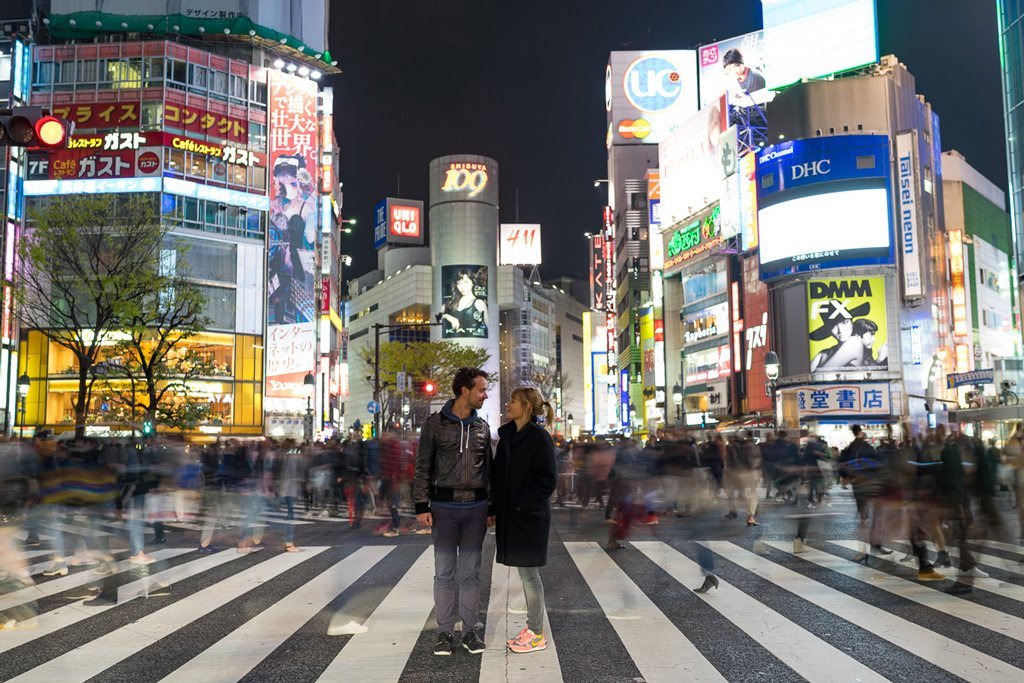
Shinjuku: for shopping fans
Shinjuku is the part of Tokyo you’ve most likely seen on TV: bustling streets, glittering futuristic buildings, and above all, infinite shopping opportunities.
This neighborhood has an especially large selection of places to stay, making it very popular with tourists.
Shinjuku also houses one of Tokyo’s major train stations, Shinjuku Station. Not only can you comfortably reach the whole city from here, you can also use it as a starting point for trips to the surrounding area, for example to Mount Fuji.
You should also make sure to check out the area around the Golden Gai, a tangle of small streets full of bars and restaurants that’s hardly changed since the days of World War II.
Our tips for where to stay in Shinjuku
The choice of places to stay is much greater in this neighborhood, with over 100 hotels listed on booking.com. But even here it’s impossible to get away with rates under 50 euros per night, unless you find a bargain somewhere!
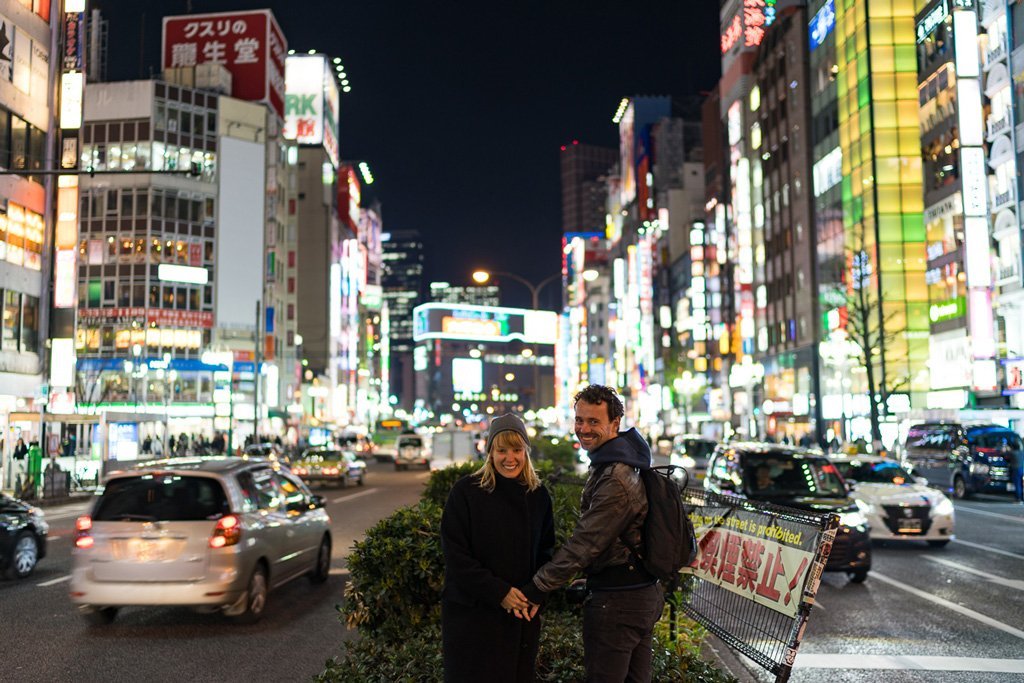
Ueno: parks and temples
Ueno is located in the east of Tokyo and is easy to reach with the Yamanote Line. There are quite a few advantages to staying here: For example, the accommodation rates are far lower than in the hip districts in the West and you’re a bit removed from the brouhaha of the city.
Ueno is home to the giant Ueno Park, the Tokyo National Museum, the National Science Museum, and the Tokyo Metropolitan Art Museum. The quieter Yanaka area of Ueno also houses over a hundred temples. Great for taking a walk and relaxing!
Our tips for where to stay in Ueno
Since Ueno isn’t one of the hyped-up neighborhoods in the west, hotel rates are much more affordable. You’ll even find the odd good budget hotel or two!
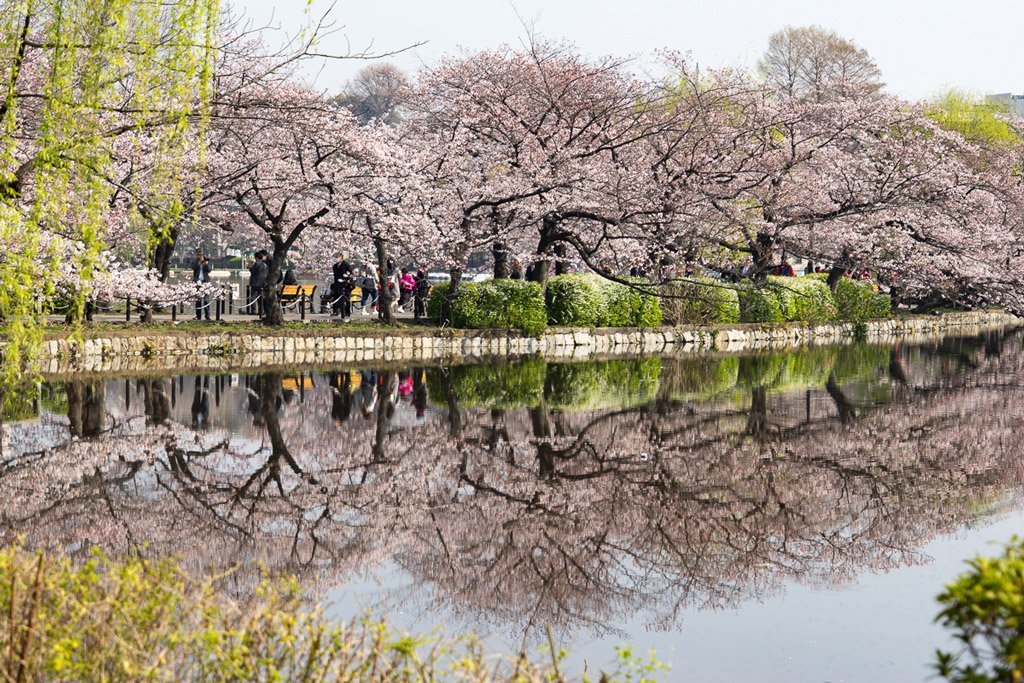
Asakusa: The old Tokyo
Asakusa is located to the southeast of Ueno and is the part of Tokyo least affected by the massive modernization of the western districts.
Hardly anything has changed here for decades, the atmosphere is more relaxed and more traditional, and not as anonymous as in the hip metropolitan areas.
You can also find traditional Japanese ryokans here, small inns with futon beds, a traditional onsen (hot spring bath), and nothing but Japanese food. A must-try on a trip to Japan!
Our tips for where to stay in Asakusa
Asakusa is a bit off the east, but it’s well connected to the rest of the city by the Yamanote Line. Hotels here are usually cheaper than in the rest of the city.
Tokyo Station Area
For many people, the area around Tokyo Station is the first they’ll see of Japan. The red-brick building itself is over one hundred years old and was extensively renovated in 2012.
Tokyo’s central station is the main hub for public transportation in Japan, meaning you can easily reach every corner of the island by bus or by train from here.
The atmosphere around the station feels very European and there are lots of restaurants and shops, including inside the station itself.
The area in general is very stylish and neat, and you’ll see businesspeople rushing past you wherever you look. Not only can you conveniently take the metro from here to the rest of the city, but the Imperial Palace and its beautiful parks are just around the corner. You can even walk there!
Our hotel tips for the Tokyo Station Area
The area around the Tokyo train station belongs to the fancier part of the metropolis, so most the hotels here are pretty expensive. But they’re also very good! Unfortunately, there’s nothing to be had for under 50 euros a night. After all, a city like Tokyo has its price!

Ginza: Tokyo’s answer to New York’s 5th Avenue
Ginza is synonymous with luxury in Tokyo. The shopping district is the first in Tokyo to adapt to the western style of shopping, with wide streets, luxury boutiques, world-class restaurants, and well-dressed businessmen and women.
Even if shopping in this neighborhood would break the bank for you, it’s worth visiting anyway just to see it for yourself.
Besides visiting the Ginza Graphic Gallery or the Sony Building, you can go for an extravagant stroll here, walk to the nearby Imperial Palace close to Tokyo Station or simply go window-shopping.
Where to stay in Ginza
You probably won’t be surprised to learn that there are no budget hotels in Ginza. But if you shop around, you might find a bargain or two. On the other hand, there are luxury hotels as far as the eye can see!
Roppongi: nightlife hub
Roppongi is the neighborhood in Tokyo where you can sit down in a bar or a restaurant and you’ll automatically be addressed in English. It’s one of the most popular nightlife spots in the city, especially among travelers and expats, and the streets are full of clubs, bars, and restaurants.
It’s also home to the National Art Center Tokyo, the Nogi-jinja Shrine, and the Mori Art Museum. So Roppongi not only has a lot to offer in terms of night-time entertainment, but it also has quite a few attractions to keep you busy during the day. Nevertheless, it’s a great area for party animals.
One slight drawback: Roppongi isn’t on the Yamanote Line, but you can easily get there with the other metro lines.
Our tips for where to stay in Roppongi
Roppongi might sound like the kind of place where you’d find a few budget hotels, but that simply isn’t the case.
The lower price classes are hardly represented here at all. But you’re spoiled for choice if you’re willing to spend more than 100 euros per night.
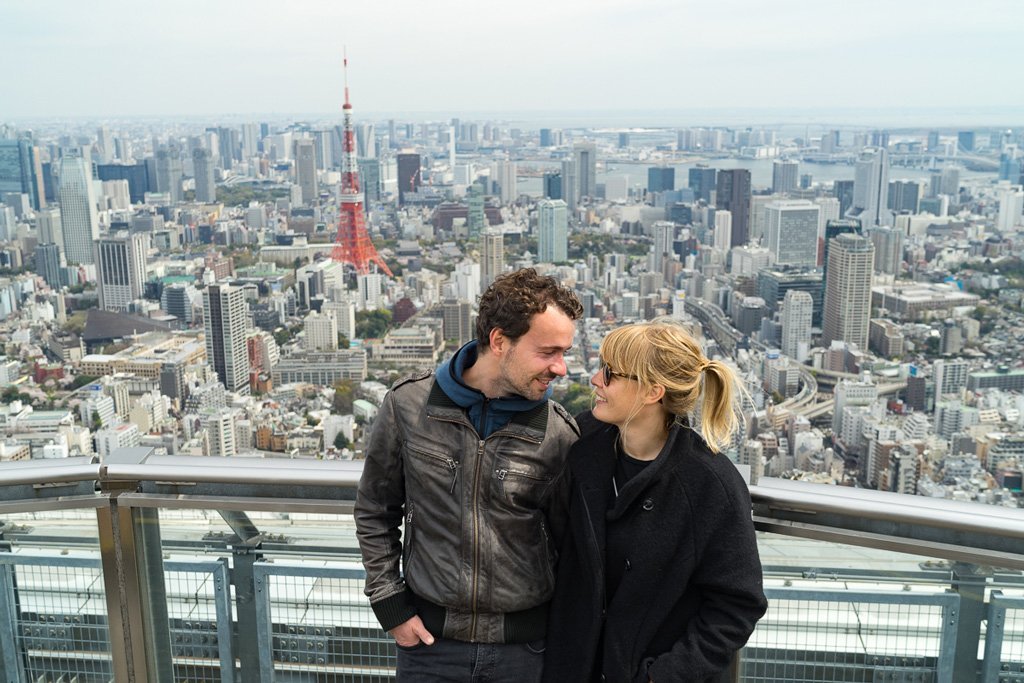
Where we stayed in Tokyo
Super Hotel Lohas Akasaka
We spent 8 out of 10 nights in Tokyo at the Super Hotel Lohas Akasaka. The hotel has a very good and central location and provides good value for money for Tokyo, especially during the expensive cherry blossom season.
It’s only a 5-minute walk from the hotel to the metro and there are supermarkets, drugstores, and lots of restaurants in all price categories right around the corner.
The rooms are simple but clean, but you’ll have to get really organized to fit your bags, etc. into the 10-square-meter rooms.
But as we mentioned above, at that price you can only get a mid-range hotel in Tokyo. If you want a bit more luxury, you’ll have to be prepared to pay a premium.
The room was so small, it was impossible to take a picture of our room. So just take a look at the photos on booking.com to get a better impression of the hotel.
InterContinental Hotel Tokyo Bay
We were treated to a bit more luxury for our last two nights in Tokyo because we were invited by the InterContinental Hotel Tokyo Bay. Of course the rooms are much larger, more stylish, the beds are much more comfortable, and the view is amazing! But the quality of the rooms and the location come at a price.
There’s a good reason that the hotel chain is popular among all those who don’t just travel to experience extraordinary places and new perspectives (just take a look at that view!), but also who appreciate some glitz and glamor.
But if you’re traveling to Japan outside the cherry blossom season and book early enough, you can get a room here starting at 200 euros per night.
We felt very much at home here and could have spent hours at the window enjoying the view of the skyline and the Rainbow Bridge. Breathtaking! The hotel’s location was great too. It’s a two-minute walk from the metro station, and only 5 minutes from some great restaurants and supermarkets.
Hamarikyu Gardens is only a few minutes’ walk away, and it only takes 20 minutes to get to the famous Tsukiji Fish Market.
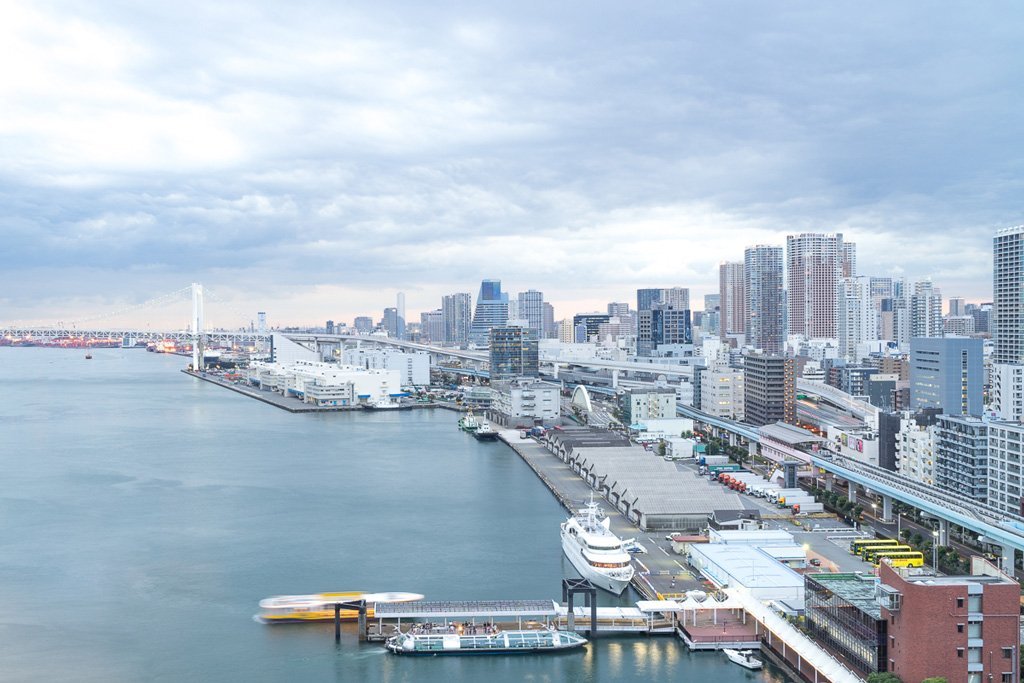
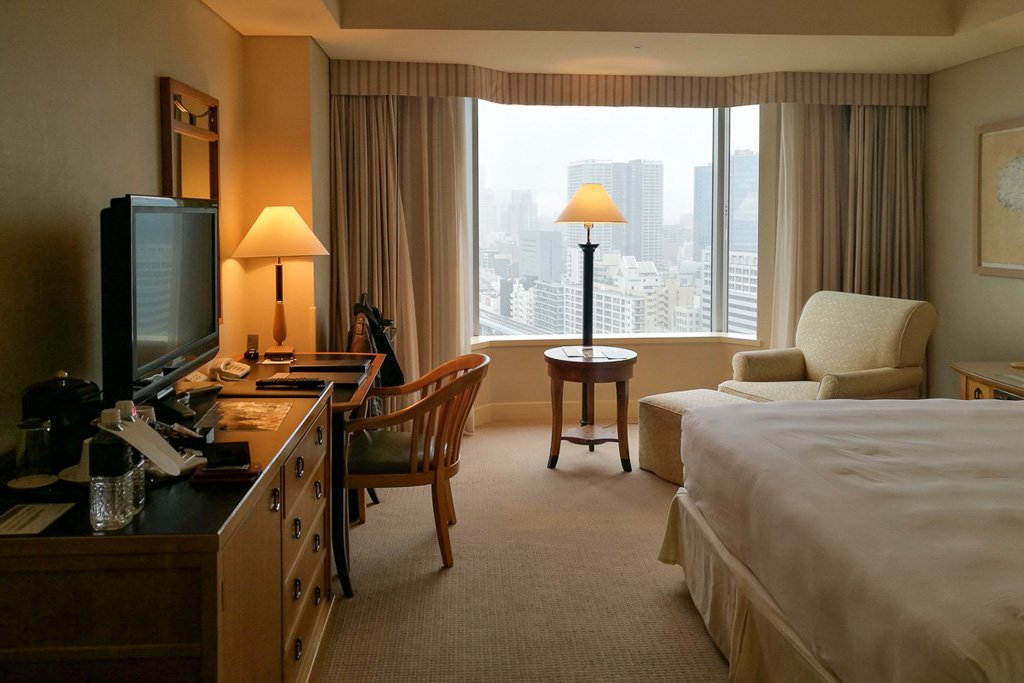
Tips for searching for a place to stay in Tokyo
Tokyo is really huge, but not some neighborhoods are more suited to searching for a hotel than others. That’s why we’ve picked out the 7 most popular neighborhoods in the east and west of Tokyo to help you with your search.
But first here are 5 tips for searching for a hotel in Tokyo.
Tip #1: Look for a hotel as soon as possible
Japan is a popular destination. You’ll realize this as soon as you start searching for a hotel too late in the game. We booked our accommodation about two months in advance and we were way too late.
To make sure you get the best selection and hotels with the best value for money, you should book as early as possible.
Tip #2: Metro stop nearby & central location
Most sights are connected by the popular JR Yamanote Line, Tokyo’s circle line. We recommend staying close to one of the stops on this line so you can easily reach all the interesting parts of the city. Alternatively, a hotel near a metro station is great too.
Although the hotels outside the center are cheaper, we recommend spending a bit more and staying right in the city center.
If you stay in the outskirts and head into town in the morning and back in the evening, you’ll be sharing the metro with the working population, and to put it delicately: Sardines in a can have more space to breath.
Taking the metro is no fun in the overcrowded trains at rush hour. We were just glad that our hotel was right in the center so we only experienced a watered-down version of this.
Tip #3: Pay attention to the size & price
Hotel rooms in Tokyo are usually very small, but they generally have everything you need. Most hotel rooms in the city center have room sizes between 9-14 m². If you want more space, you’ll have to shell out a bit extra.
And yes, hotels in Tokyo and in the rest of the country are expensive. But we found that you really ‘get what you pay for’ in Tokyo. If you have high expectations for a hotel, then you should be prepared to spend at least 150 euros per night.
For example, our first hotel in Tokyo, the Super Hotel Lohas Akasaka, costs 150 euros per night, and if we’re being honest: It was a lower mid-range hotel with 11 m² rooms. No more, no less. You can read more about our hotel in the section “Where we stayed in Tokyo”.
For under 100 euros, however, all you’ll get is a dorm bed. By the way, we couldn’t find a single hostel with mixed dorms. So if you’re traveling as a couple, you’ll have to be prepared to sleep in separate dorms.
Starting at around the 100 euro price point, you’re likely to get an ok hotel, and the really nice hotels start at around 200 euros per night.
Our recommendation: We’ve also listed some cheaper hotels here. If you’re traveling alone and want to try a capsule hotel, that’s a pretty affordable accommodation option. However, most capsule hotels are men-only.
Otherwise we recommend applying filters to search for hotels for 100 euros and up and then sorting them by review score. We usually apply a filter to only include scores of 9 and up and if we don’t see anything we like, we extend it to 8 points and up.
Tip #4: Make sure you get a non-smoking room.
Obviously only if you don’t want to sleep in a smoking room. Japan is still a country of smokers, although that’s starting to change. There are still very many hotels where you can smoke.
If you look at a hotel on booking.com, you can either look for non-smoking rooms in the room type section (you can also filter for this), or check whether the entire accommodation is smoke-free. To find that out, scroll down a bit further to the “Facilities” section. If you’re lucky, it’ll read “Non-smoking throughout” under “General” on the right-hand side.
Tip #5: Don’t use the toiletries provided at the hotels.
That might sound like weird advice, but it isn’t. Because toiletries in Asian countries often contain skin-whitener. If you want to avoid a free skin-bleaching, then you’d best avoid any toiletries provided.
And if you’re thinking “I’m sure it would say so on the bottle”, you’re probably right. But since all the ingredients are listed in Japanese, you’ll never know. So better to be safe than sorry.
Of course that doesn’t apply to international chains such as our second hotel in Tokyo, the InterContinental Tokyo Bay. They cater specifically to western guests.
Your hotel tips for Tokyo
Those were all our tips for where to stay in Tokyo. We hope we were able to help you, and you feel more confident searching now.
Have you ever been to Tokyo? Where did you stay and would you recommend it to others? Please let us know in the comments below!
